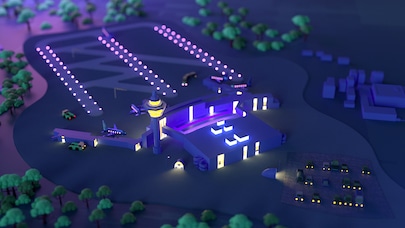What is 5G?
What is 5G?
5G is the fifth generation of wireless mobile technology, bringing revolutionary improvements in speed, latency, and capacity to wireless connectivity. Unlike previous generations, which amounted to upgrades to previous mobile networks, 5G is a new comprehensive network architecture that provides a platform for new services, applications, and business models. 5G delivers fiber-like wireless access speeds, providing increased capacity and more reliable wireless communications.
How fast is 5G?
5G is designed to deliver fiber-like speeds – theoretically as high as 10Gbps. This means that 5G networks will be able to transmit data at lightning speeds, allowing users to download movies, stream videos, and play games in seconds. Providing a much higher throughput than previous generations, 5G also carries more bits of data per watt of energy – making it more efficient and helping CSPs to reach zero carbon emissions.
Another significant advantage of new 5G architectures and technologies is reduced latency or the delay between sending a signal and receiving a response. 5G networks have latency as low as one millisecond, which is up to 50 times faster than 4G. This makes 5G ideal for real-time applications like gaming, virtual reality, and remote equipment operations.
How does 5G work?
In the radio access network (RAN), radio antennae transmit and receive signals to a wireless endpoint – such as a smartphone, laptop, or machine. It provides a wireless connection between the device and core network. The base station transceiver (BTS) comprises an antenna, radio equipment, and signal-processing software. Each BTS covers a defined area or cell. Nokia’s 5G BTS is known as AirScale.
Also new for 5G radio communications is massive Multiple Input Multiple Output (MIMO). Massive MIMO is employed in 5G to increase the capacity and speed of the network. MIMO uses multiple antennas to send and receive data, enabling multiple data streams to be transmitted simultaneously. Read more on massive MIMO.
The 5G Core is the heart of the network, authorizing a device’s connection, enabling its mobility, ensuring privacy and security, and delivering services. The core connects devices with applications, private networks, and the internet.
5G is the first ‘cloud generation’ mobile infrastructure. 5G network elements were designed for cloud deployment from inception to aid in cost efficiency, scalability and agility. For example, Edge Cloud, Cloud RAN and converged cloud core deliver greater agility and reliability of the network and faster service creation and instantiation.
Mobile transport– behind every mobile network is a transport network interconnecting the RAN and core functions. Moreover, a mobile transport infrastructure likely needs attention to adequately support 5G’s increased speeds and capacity. The transport network also provides resilient, low latency and secure real-time connectivity using a mix of microwave, broadband, IP, and optical technologies to transport the ever-growing traffic volume.
What frequencies does 5G use?
5G utilizes low-, medium- and high-band spectrum frequency ranges depending on the network application. Lower frequencies cover wider distances and penetrate structures better. Higher frequencies trade off coverage and penetration for greater data throughput and capacity.
- Low-band frequencies: Low band refers to the frequency between 450MHz and less than 1 GHz. This frequency is ideal for providing widespread coverage in urban and rural areas. However, the data transfer speeds on low-band frequencies are not as fast as on high-band frequencies.
- Mid-band frequencies: Mid-band frequencies range between 1 GHz and 6 GHz. Mid-band frequencies offer a good balance between coverage and capacity. They provide higher data transfer speeds than low-band frequencies while covering a larger area than high-band frequencies.
- High-band (millimeter wave) frequencies: High-band frequencies range from 24 GHz and above. High-band frequencies offer very high data transfer speeds, low latency, and high capacity, though with limited coverage areas. Additionally, high-band waves do not effectively penetrate buildings and obstacles.
How is 5G infrastructure different to 4G or Wi-Fi?
5G enhances capacity and provides multi-connectivity. Compared to 4G, 5G's high speeds, reliability, and fast response rate will enable new use cases, such as integrated public transport management, autonomous systems, smart industries and immersive experiences – making previously unviable activities possible.
5G comprises programmable network operating systems, dynamic data security, and the capability to support one million ‘things’ per square kilometer. Unlike Wi-Fi, this makes it possible to manage and control network and service performance and respond immediately to changes in environmental conditions.
5G takes slices of the network and assigns different policies to specific use cases as the network functions and applications on top can be fully cloudified.
What is the evolution of 5G?
5G-Advanced is the next step in 5G cellular technology’s standards evolution. It brings a new level of enhanced capabilities beyond connectivity and enables a broader set of advanced use cases for verticals. It will support advanced applications with enhanced mobility and high reliability, as well as AI and machine learning (ML) that will increase network performance and introduce further improvements in spectral efficiency and energy savings. See this page for more on 5G-Advanced.
Following on from 5G-Advanced, 6G will fuse the human, physical and digital worlds to deliver a network that takes us from connectivity to togetherness, information to knowledge, and effectiveness to purpose – helping us redefine how we live, work, and care for our planet. See this page for more on 6G.
What (market) impact will 5G have?
The impact of 5G on the market is likely to be significant, with the potential to create new revenue streams, improve efficiency, drive customer engagement, increase competition, create new opportunities for startups, and disrupt traditional business models. For example, 5G’s advanced connectivity and digital service support will enable cities and industries – such as manufacturing, energy and agriculture – to become smarter. And because advanced connectivity can substitute physical journeys, it will also help to reduce carbon emissions.
If we look ahead to life in 2030, 5G networks will power digital economies and societies. Ever-present connectivity will help close the digital divide by making it easier for people to access educational, public health and business information regardless of location.
How will 5G benefit industries?
5G enables the digital transformation of physical industries and improves safety, productivity and efficiency for key business sectors such as manufacturing, logistics, agriculture and mining.
For example, creating a digital twin of an assembly line reduces operational and maintenance costs, while crewless autonomous vehicles in mines increase workers’ safety. In turn, those industrial gains trigger a virtuous cycle of societal value creation.
5G unleashes infinite new possibilities for industries, governments, and cities that dream of building a more agile, digital, resilient and sustainable future. It allows them to re-design physical operations in real-time, optimize efficiency, productivity and safety, then put it all into action with the click of a button.
Industries can operate more effectively, meeting business and sustainability goals while maintaining the continuity of their operations, no matter how markets shift or environmental conditions change.
How will 5G benefit consumers?
5G enables an entire ecosystem of companies to work together to create various new personalized digital services based on user preferences and locations powered by augmented and virtual reality (AR/VR). 5G will play a critical technical role in bridging the physical and virtual worlds via the Metaverse.
Explore related 5G topics
Latest 5G news
Learn more about 5G
Video
Revolutionizing connectivity across Africa through Network-as-a-Service

Blog

Blog

Blog

Blog

Blog











